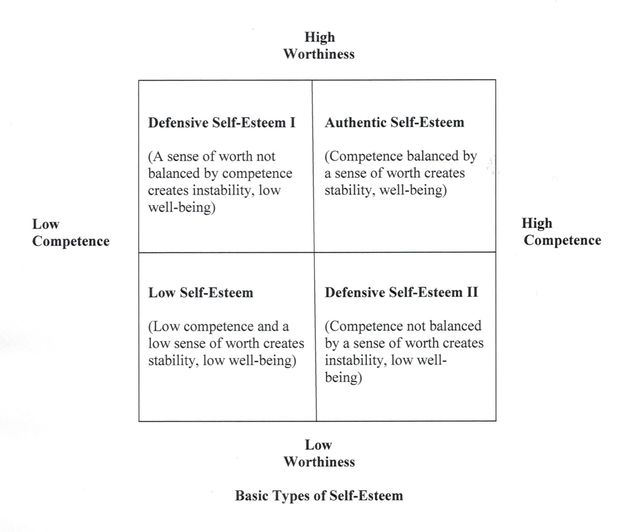Self-Esteem
Authentic Self-Esteem and Well-Being: Part II - Two Factors
The basic types of self-esteem.
Posted July 27, 2018
Authentic Self-Esteem and Well-Being: Part II – Basic Types of Self-Esteem
As mentioned in the previous blog, social scientists define self-esteem in three major ways. Self-esteem can be seen in terms of success or competence, feeling good about oneself or worthiness, and as a relationship between competence and worthiness (Mruk, 2019, 2013). The first two definitions include the one most commonly used today, namely, having sense of worth or feeling good about oneself as a person. However, defining self-esteem in terms of either competence or worthiness alone are seriously problematic because they leads to conclusion that contract the very meaning and value of healthy self-esteem. For example, people who are very competent or successful at doing bad things, such as lying, bullying, and much worse, must be seen as having high or positive self-esteem if we use the competence-based definition to define it. Similarly, defining self-esteem in terms of worth or feeling good about oneself would force us to conclude that narcissists have authentic self-esteem.
Most people would not agree that antisocial behavior and narcissism reflect genuine, positive, and healthy or “authentic” self-esteem. There are two major benefits of defining self-esteem as a relationship between competence and worthiness. The first one is that this “two-factor approach, as it was previously identified, is not vulnerable to the so-called dark sides of self-esteem described above because when the two factors balance each other, they eliminate such negative possibilities. For instance, someone who is competent at doing “bad” things cannot be seen as having authentic self-esteem according to this view, because his or her behavior is unworthy of a mature, fully functioning adult. Similarly, another person who feels good about himself or herself, but did nothing to merit such an opinion, would not demonstrate the competence that would justify such a belief. Another important reason to define self-esteem this way is that competence and worthiness are important for personal and interpersonal well-being as will be discussed later in another blog.
One way of appreciating the advantages of defining self-esteem as a relationship between two factors is that this approach shows how we must consider four types of self-esteem instead of just high self-esteem and low self-esteem common to the other definitions do. This characteristic can be presented visually in a simple diagram based on the two basic components of self-esteem.

As can be seen in the diagram, each major type of self-esteem is characterized by two features. One is the nature of the relationship between competence and worthiness that creates the possibility of types in the first place. If one factor is represented by a vertical line and the other by one that is horizontal, the relationship between these two variables inevitably result in four basic types of self-esteem. The other major feature is that each one of them can be roughly divided into two subtypes or levels of self-esteem. One of them is more unusual or extreme in terms of the number of people who live a particular combination of competence and worthiness affects. This level is represented in the nearer the outer borders of each quadrant in the diagram. The other level is a “milder” version of the same set of characteristics and is more common in society. This level occurs in the area of the quadrant that is more toward the center of the diagram.
All of the types and levels have implications for personal and interpersonal well-being. For instance, even those who criticize the value self-esteem acknowledge that it helps people tolerate stress better and is also linked to higher degree of happiness. In addition, except for the area characterized by a positive degree of competence and worthiness, all of the other extreme levels are associated with as many as 24 of mental health disorders (O’Brien, Bartoletti, Leitzel, & O’Brien, 2006). In my books on self-esteem, there is adequate space to describe each type and level very thoroughly. What I can do here is to present the idea that defining self-esteem in terms of a relationship between competence and worthiness allows us to consider high, low, medium, and two defensive forms of self-esteem. I describe all of them in the next of the blog, namely, part III.
References
Milton, J. (1950). Apology against a pamphlet. In C. Brooks (Ed.), Complete poetry and selected prose of John Milton. New York, NY: Modern Library. (Original work published 1642)
Mruk, C. J., (2019). Feeling good by doing good: A guide to authentic self-esteem. New York, Oxford University Press.
Mruk, C. J., (2013). Self-Esteem and positive psychology: Research, theory and practice (4e). New York: Springer Publishing Co.
O’Brien, E. J., Bartoletti, M., Leitzel, J. D., & O’Brien, J. P. (2006). Global self-esteem: Divergent and convergent validity Issues. In M. H. Kernis (Ed.), Self-esteem: Issues and answers (pp. 26–35). New York, NY: Psychology Press.


